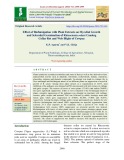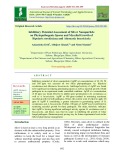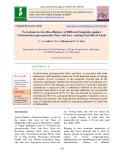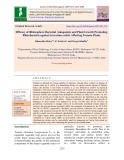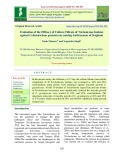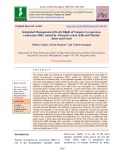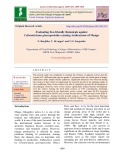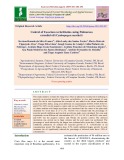
Significantly inhibited the mycelial growth
-
An experiment was conducted during Kharif season of 2017-2018 at the Central Research Farm of Sam Higginbottom University of Agriculture Technology and Sciences, to evaluate the efficacy of bio-agents and botanical extracts against anthracnose (Colletotrichum lindemuthianum) of black gram (Vigna mungo L.) both in vitro and in vivo. In vitro studies showed significant difference in the inhibition per cent of mycelial growth of the pathogen among all the treatments.
 8p
8p  chauchaungayxua12
chauchaungayxua12
 29-07-2021
29-07-2021
 15
15
 1
1
 Download
Download
-
Twelve fungicides including systemic and non-systemic, five bioagents and eight plant extracts were evaluated in vitro against Exserohilum turcicum, the causal agent of Turcicum leaf blight of maize. All the test fungicides, bioagents and plant extracts showed fungistatic action and significantly inhibited mycelial growth of the test pathogen over untreated control.
 9p
9p  angicungduoc8
angicungduoc8
 07-11-2020
07-11-2020
 15
15
 2
2
 Download
Download
-
Early blight of potato caused by Alternaria alternata is one of the major diseases causing considerable yield loss. Efficacy of bio-agents was studied and revealed the all four Trichoderma species significantly reduced the mycelial growth of the pathogen over the control by dual culture method. Significantly maximum inhibition of mycelial growth was obtained with T. viride (57.08%) followed by T. azospirillum (50.00%), T. harzianum (43.26%) and T. virens (37.08%) of the pathogen after 48 hours of incubation. In present study, T. viride was observed more inhibitory against A. alternata...
 6p
6p  kethamoi7
kethamoi7
 26-08-2020
26-08-2020
 11
11
 2
2
 Download
Download
-
Soybean [Glycine max (L.) Merrill.] is an important oilseed crop. Colletotrichum truncatum, the incitant of anthracnose/ pod blight in soybean is one of the most destructive pathogens. Eight fungicides (@ 500, 1000, 1500, 2000 and 2500ppm each), 10 botanicals@ 10% and four bioagents were evaluated in vitro against C. truncatum, using PDA as basal medium. The results revealed that all the fungicides, botanicals and bioagents tested were found fungistatic and significantly inhibited the mycelial growth of the test pathogen over untreated control.
 6p
6p  nguaconbaynhay7
nguaconbaynhay7
 15-08-2020
15-08-2020
 18
18
 1
1
 Download
Download
-
To manage the disease an investigation at the Department of Plant Pathology, SHIATS-DU, Allahabad was carried out to evaluate the effect of bio-agents viz. Trichoderma viride @ 2%, Pseudomonas fluorescens @ 2%, T. harzianum @ 2%, botanical viz. neem leaf extract @ 5%, neem oil @ 5% and fungicide viz. carbendazim @ 0.2% against R. solani under invitro condition by dual culture and poisoned food technique. All the bioagents and botanical were evaluated singly. All the treatments significantly inhibited the mycelial growth of R. solani as compared to untreated check.
 5p
5p  chauchaungayxua6
chauchaungayxua6
 26-06-2020
26-06-2020
 11
11
 2
2
 Download
Download
-
Among the tested five non-systemic, three combi- products, three systemic fungicides against Peziotrichum corticolum under laboratory condition, Bordeaux mixture, Copper oxychloride, Mancozeb, Carbendazim + Mancozeb, Hexaconazole + Zineb recorded maximum (100%) mean percent inhibition of P. corticolum, followed by Cuprous hydroxide (96.39%), Propiconazole (95.56%), Captan + Hexaconazole (86.39%), Difenconazole (80.74%), Hexaconazole (74.07%), Chlorothalonil (73.92%). Among the five plant extracts (botanicals), maximum mean percent inhibition of mycelial growth (22.
 10p
10p  chauchaungayxua6
chauchaungayxua6
 26-06-2020
26-06-2020
 18
18
 1
1
 Download
Download
-
Fusarium oxysporum f. sp. ciceri is one of the most destructive pathogen, causing wilt disease in chickpea and thereby inflicting accountable quantitative (48.29%) as well as qualitative losses. All the six fungal and two bacterial bioagents tested in vitro, exhibited significant mycelial growth inhibition of Fusarium oxysporum f. sp. ciceri. However, Trichoderma viride recorded significantly highest mycelial growth inhibition (75.55%), followed by Trichoderma harzianum (73.77%) Trichoderma koningii (71.88%) and Pseudomonas fluorescens (43.77%).
 5p
5p  nguaconbaynhay6
nguaconbaynhay6
 23-06-2020
23-06-2020
 11
11
 1
1
 Download
Download
-
Pomegranate (Punica granatum L) is one of the important fruit crops grown in India. Leaf spot of pomegranate caused by Alternaria alternata (Fr.) Keissler has becoming a major limiting factor in cultivation of pomegranate in some regions of India. The present investigation was carried out to test the efficacy of bio-agents and botanicals in vitro. All the seven fungal and two bacterial antagonists tested, exhibited significant mycelial growth inhibition of A. alternata. However, T. viride recorded significantly highest mycelial growth inhibition (86.
 10p
10p  gaocaolon5
gaocaolon5
 14-06-2020
14-06-2020
 13
13
 0
0
 Download
Download
-
Clusterbean [Cyamopsis tetragonaloba (L.) Taub], an important legume crop in India. Alternaria spp. is an economically important pathogen widely distributed throughout the world and cause devastating disease on field crops. A total of eight commonly available botanicals were evaluated in the form of crude extracts against the growth of Alternaria cyamopsidis under in-vitro condition. Results of the in vitro evaluation of various botanicals against A. cyamopsidis revealed that all the test botanicals significantly inhibited mycelial growth of A. cyamopsidis, over untreated control.
 4p
4p  kethamoi5
kethamoi5
 03-06-2020
03-06-2020
 13
13
 0
0
 Download
Download
-
In vitro inhibition of the five different aroma chemicals were studies against three seed borne fungal pathogen species in the concentration range of 500 and 1000 ppm. All aroma chemicals were found effective, the eugenol inhibited the maximum mycelial growth significantly which is followed by terpineol. The phenyl acetate showed least mycelial inhibition of the fungi. Over all in the present investigation, eugenol was found most effective aroma chemical against the species of Curvularia, Drechslera and Bipolaris.
 6p
6p  trinhthamhodang5
trinhthamhodang5
 16-05-2020
16-05-2020
 11
11
 1
1
 Download
Download
-
Rice sheath blight pathogen Rhizoctonia solani was isolated from the diseased samples obtained from Agricultural Research Station, Nellore. Pathogenicity of R. solani on rice leaves was assessed following detached leaf technique. The herbicides viz., Glyphosate, 2,4-D Sodium salt, Butachlor, Pretilachlor, Oxadiargyl, Pyrazosulfuron ethyl, Bensulfuron methyl 0.6% + Pretilachlor 6%, Cyhalofop-butyl, Bispyribac sodium and Ethoxy sulfuron were tested at recommended concentrations by poisoned food technique were significantly superior over control in checking the mycelial growth of R. solani.
 6p
6p  nguaconbaynhay5
nguaconbaynhay5
 16-05-2020
16-05-2020
 16
16
 0
0
 Download
Download
-
Sorghum [Sorghum bicolor (L.) Moench] is a vital life-sustaining food crop for human being as well as for livestock in many parts of world. In India, Maharashtra, Karnataka, Andhra Pradesh, Madhya Pradesh, Gujarat and Tamil Nadu are major sorghum growing states. Therefore, investigation was undertaken during 2016 at N. A. U., Navsari on isolation of sorghum seed infecting fungi, (Colletotrichum sp., Fusarium moniliforme, Alternaria alternata, Curvularia lunata, Macrophomina sp., Aspergillus niger and A. flavus.
 4p
4p  nguaconbaynhay5
nguaconbaynhay5
 11-05-2020
11-05-2020
 13
13
 1
1
 Download
Download
-
Plants synthesize secondary metabolites and some of them as well as their derivatives have antimicrobial activity such as alkaloids, flavonoids, isoflavonoids, tannins, coumarins, glucosides, terpenes and phenolic compounds. An attempt was made to evaluate the in vitro antifungal and biofumigant nature of ten different plants on suppression of mycelial growth of R. solani. Among these plant extracts at a concentration of 12.5%, total inhibition of the pathogen was obtained on PDA incorporated with leaf extracts of cabbage and garlic creeper. The extracts of leaves of sweet potato (37.
 10p
10p  trinhthamhodang1212
trinhthamhodang1212
 06-04-2020
06-04-2020
 13
13
 1
1
 Download
Download
-
Inhibitory potential of silver nanoparticle (AgNP) at concentrations of 10, 20, 50 and 100 ppm was assessed on two foliar phytopathogens viz. Bipolaris sorokiniana and Alternaria brassicicola. Antifungal activity of AgNP was found to be significant in reducing germinating spores as well as mycelial growth of both pathogens in an experiment under controlled condition. AgNP at a concentration of 20 ppm was found effective to inhibit spore germination in B. sorokiniana as well as A. brassicicola. AgNP at 100 ppm resulted in restricting maximum mycelial growth for both pathogens.
 8p
8p  caygaocaolon4
caygaocaolon4
 04-04-2020
04-04-2020
 10
10
 1
1
 Download
Download
-
Colletotrichum gloeosporioides Penz. and Sacc. is associated with aonla anthracnose, and fungicides remain one of the important means to manage the disease. In-vitro evaluation of the fungicides revealed that all the treatments significantly inhibited mycelial growth of the test pathogen over untreated control.
 13p
13p  caygaocaolon2
caygaocaolon2
 11-03-2020
11-03-2020
 9
9
 0
0
 Download
Download
-
Tomato is affected by a large number of diseases. Among these, collars rot disease of tomato cause by S. rolfsii is a threatening disease in eastern coastal regions of Odisha. Since, this disease is soil borne in nature, it is very difficult to control by chemical fungicides. The native rhizosphere soil of tomato was used for isolation and screening of bacterial antagonists for their efficacy and growth promotion potential. A total of 54 bacterial isolates were isolated from rhizosphere of tomato of which five isolates viz.
 12p
12p  trinhthamhodang3
trinhthamhodang3
 22-02-2020
22-02-2020
 26
26
 1
1
 Download
Download
-
In the present study, the efficiency of 15 day old culture filtrate (nonvolatile compound) of 20 Trichoderma isolates was evaluated at 10% and 25% concentration using poison food technique against mycelial growth C. graminicola. All the 19 isolates of Trichoderma asperellum and one isolate of Trichoderma harzianum were significantly reduced the mycelia growth of C. graminicola over control at 10% and 25% concentration. The maximum reduction of mycelia growth of C. graminicola at 10% and 25% of T4 isolate which recorded 68.18% and 80.68% inhibition radial growth respectively.
 6p
6p  nguaconbaynhay3
nguaconbaynhay3
 07-02-2020
07-02-2020
 6
6
 0
0
 Download
Download
-
The present study was carried out to find the integrated management of early blight of tomato (Lycopersicon esculentum Mill.) caused by Alternaria solani. Tomato (Lycopersicon esculentum Mill.) is an important vegetable crop which is grown all over the world. Early blight of tomato, caused by Alternaria solani is one of the most important diseases in tomato. Two fungicides i.e. Mancozeb 75 WP and Hexaconazole 5 EC at different concentrations (0.1%, 0.2% and 0.3%), two bio-agents viz., Trichoderma harzianum and T. koningii and two botanicals i.e.
 9p
9p  nguathienthan2
nguathienthan2
 26-12-2019
26-12-2019
 14
14
 0
0
 Download
Download
-
The present study was conducted to evaluate the efficacy of aqueous extract and dry extracts of 12 different plant species against C. gloeosporioides the causal agent of mango anthracnose under natural disease epidemics. Significant difference was observed among the extracts in their effect on suppressing the mycelial growth of the pathogen under in vitro conditions. None of the extracts were able to completely prevent the development of the pathogen. However, most of the extracts significantly reduced disease development over the control. Among the fresh plant extracts, at 7.
 8p
8p  nguathienthan2
nguathienthan2
 25-12-2019
25-12-2019
 10
10
 0
0
 Download
Download
-
This study aimed to evaluate the fungi toxic effect of palmarosa essential oil (Cymbopogon martinii) on mycelial growth of Fusarium verticillioides in vitro and treatment of corn seeds. For the in vitro experiment the essential oil was added to the culture medium and poured into Petri dishes, using seven different oil concentrations (0.0125, 0.025, 0.05, 0.1 and 0.2%), 0.0% was the negative control, and we used Thiram as a positive control. Discs of culture medium with fungal mycelium were inoculated into the center of the plates and incubated for seven days at 27 ± 2°C.
 11p
11p  quenchua2
quenchua2
 18-12-2019
18-12-2019
 22
22
 0
0
 Download
Download
CHỦ ĐỀ BẠN MUỐN TÌM








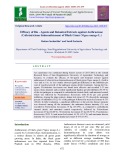

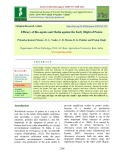
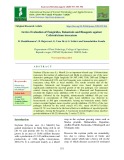
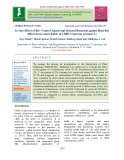
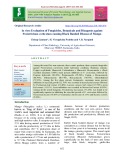
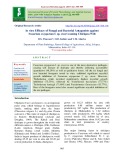
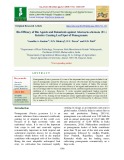
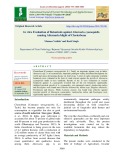
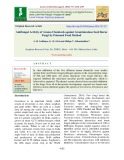
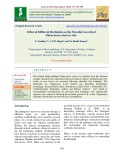
![Management of sorghum [Sorghum bicolor (L.) Moench] seed mycoflora by means of bio-agents in vitro Management of sorghum [Sorghum bicolor (L.) Moench] seed mycoflora by means of bio-agents in vitro](https://tailieu.vn/image/document/thumbnail/2020/20200511/nguaconbaynhay5/135x160/3841589213360.jpg)
